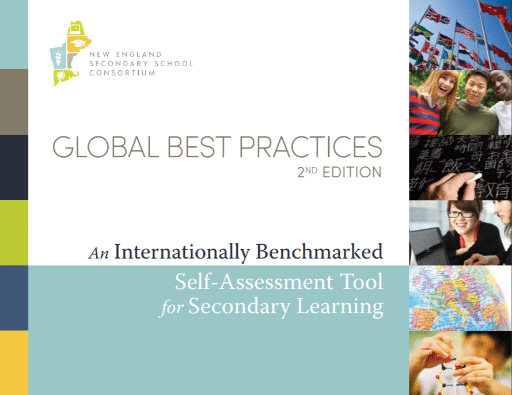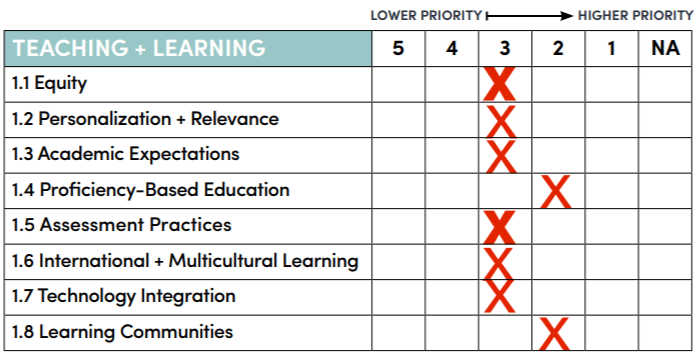Global Best Practices – A Practical Tool for School Self-Assessment and Action Planning
CompetencyWorks Blog
 Global Best Practices is an outstanding, free resource that offers a practical, step-by-step process for assessing your school or district to inform school improvement plans. It focuses on common characteristics of high-performing schools and districts, as documented in the accompanying Research Summary.
Global Best Practices is an outstanding, free resource that offers a practical, step-by-step process for assessing your school or district to inform school improvement plans. It focuses on common characteristics of high-performing schools and districts, as documented in the accompanying Research Summary.
These common characteristics overlap considerably with descriptions of high-quality personalized, competency-based schools, such as those presented in iNACOL’s Quality Principles for Competency-Based Education.
The Global Best Practices tool can be used by a variety of school stakeholders, such as teachers, school and district administrators, school board members, and parents. It was developed by the Great Schools Partnership as part of their technical support of the New England Secondary School Consortium.
The tool focuses on four “strands” of school practice—teaching and learning, organizational design, school leadership, and school district—and each strand has multiple “dimensions.” For example, the dimensions of teaching and learning include equity, academic expectations, assessment practices, and others. Across the four strands, there are 22 dimensions of school practice.
Using the Global Best Practices Tool
The tool can be used very flexibly and includes a helpful Facilitators Guide. Here’s a quick overview of their basic approach, followed by some examples. First, users select which strands and/or dimensions to address. Then they take the following four steps for each dimension:
- Read the three different levels of performance descriptions.
- Discuss the provided lists of school improvement strategies.
- Record evidence of performance or progress from a list of examples, or add their own.
- Reflect on the previous three steps, score the school from 1 to 5 on the dimension being assessed. Across dimensions, the scores can help prioritize action steps.
 Consider how this process could unfold with the “assessment practices” dimension. For Step 1, you read the performance descriptions, which describe three levels of implementation—”Initiating,” “Developing,” and “Performing.” Here are parts of the descriptions of assessment practices at each of the three levels:
Consider how this process could unfold with the “assessment practices” dimension. For Step 1, you read the performance descriptions, which describe three levels of implementation—”Initiating,” “Developing,” and “Performing.” Here are parts of the descriptions of assessment practices at each of the three levels:
- Initiating – “The school primarily uses a ‘one-size-fits-all’ approach to assessment, and most assessments employ fixed-response, selected-response, and multiple-choice questions that primarily measure recall. The assessment literacy of teachers is limited, and many are unaware of research-based assessment strategies or the impact that varied assessment strategies can have on student learning.”
- Developing – “The school has started using more innovative assessment strategies—including exhibitions and portfolios” and “Faculties are supported in increasing their understanding of assessment design and in matching assessments to specified learning goals.”
- Performing – “Teachers have received training in using assessments to identify and respond to student learning needs and are skilled in the use of diagnostic assessment. Teachers use formative, performance-based assessment strategies to identify student needs. Performance assessments and demonstrations of learning are challenging, relevant, and drawn from real-life situations.”
For Step 2, you record your performance strategies. Some of the sample strategies the tool provides for the “assessment practices” dimension are:
- Provide professional development focused on building assessment literacy among teachers.
- Employ grading practices that do not penalize students for early learning struggles during the formative assessment phase.
For Step 3, school teams record performance evidence that work being done in each dimension has had a positive impact. As with the previous step, some schools may not yet have engaged in strong practices related to a given dimension or have evidence of impacts. When that’s the case, this step gives school teams a sense of the types of evidence they might want to collect in the future. For the “assessment practices” dimension, some of the sample types of performance evidence include:
- Students can explain how assessments are connected to learning expectations.
- Student exhibitions evidence high levels of creativity, innovation, intellectual sophistication, and applied skills.
For Step 4, school teams score their school after reflecting on what they learned in the previous three steps. This places them on the “continuum of improvement” that ranges from Initiating to Developing to Performing on each dimension. The scores are intended to guide school improvement efforts, and the tool emphasizes that “a low score should not be seen as evidence of failure or a cause for blame, just as a higher score should not become an excuse to rest on your laurels and stop learning and growing as a community of professionals.”
Using the Priority Guide
The tool includes a handy graphic for school teams to array their findings across the dimensions they have assessed. This can help communicate findings and identify priorities. Part of the graphic is shown below, showing a school’s findings for the “Teaching + Learning” strand.
 The tool has a very encouraging tone. It is all about supporting growth, not passing judgment. I spoke with Andi Weisman Summers, Co-director of Coaching at the Great Schools Partnership, who said that they have used Global Best Practices as a coaching tool with many schools and districts. She shared these examples of how the tool has been used:
The tool has a very encouraging tone. It is all about supporting growth, not passing judgment. I spoke with Andi Weisman Summers, Co-director of Coaching at the Great Schools Partnership, who said that they have used Global Best Practices as a coaching tool with many schools and districts. She shared these examples of how the tool has been used:
- Twenty-one schools conducted self-assessments at the beginning and end of their participation in the NextGen Personalized Learning Initiative of the New England Secondary Schools Consortium. The assessments identified dimensions to work on and showed their level of growth over the grant period. Details are provided in the project’s final report.
- Coaches from the Great Schools Partnership sometimes select a single dimension from the tool and use that as a focus for discussion and goal-setting when working with schools.
- During GSP’s annual School Redesign in Action conference, Andi and two of her colleagues led a session based on the tool’s Equity dimension, to help schools identify practices that contribute to inequity, work toward equity in their schools, and determine their school’s current performance on indicators such as moral courage and leadership. The slides from the session are here.
See also:
- Global Best Practices Facilitators Guide
- Global Best Practices Research Summary
- Quality Principles for Competency-Based Education
Eliot Levine is the Aurora Institute’s Research Director and leads CompetencyWorks.